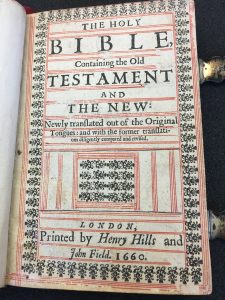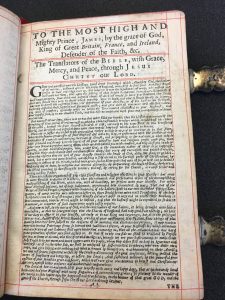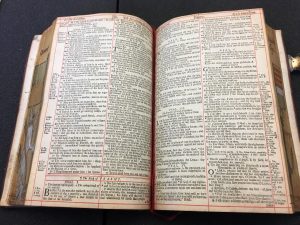The Holy Bible Containing the Old Testament and the New was published in London in 1660 by Henry Hills and John Field. The date of publication for this Bible is not only an indication that it was printed, but it also means that this Bible is an example of a King James Bible, also known as the Authorized Version. As such this Bible would have been translated from the “original tongues” meaning the original Greek or Hebrew into English rather than from the Latin Vulgate into English. However, this Bible is not representative of the standard King James Bibles that twenty-first century readers are used to. This Bible in particular consists of numerous additions that demonstrates its rarity and how it can be interpreted as a work of art in and of itself.


Take for instance, the cover of the Bible which features dark brown leather with gold border design consisting of geometric shapes and flowers. The spine of the Bible mimics these geometric designs while the book itself is sealed with two sterling silver clasps located towards the upper and lower half of the Bible. The paper of the Bible itself also demonstrates the cost and skill needed to produce this Bible. The marbled flyleaves (pages at the beginning of books used to protect the text) as well as the gilded edges demonstrate not only the cost of this Bible, but also the number of people the the original owner of this Bible would have had to visit in order to produce it. Even when Bibles were beginning to be printed in England, it was necessary for someone to visit specialists for different portions of the Bible to be made. This included illustrations, bindings, etc. With that being said, medieval Bibles would still be standard in the sense that the text was arranged into two columns with historiated initials, headings, chapter and verse numbers, and so on. This particular Bible has a few oddities which make it all the more compelling. For example, the text of this particular Bible is ruled and organized based on red lines or rubrications. For Bibles that were written by hand these lines acted as a ruling system to help the scribe write in a straight line. However, when dealing with printed books, like this particular Bible, these lines serve no purpose because the printing press would guarantee that the lines would be straight. Another peculiarity concerning this Bible is the lack of page numbers which would be an easy addition especially since this is a printed Bible. While there is no concrete answer to these irregularities, it can be hypothesized that the patron may have wanted a more “authentic” looking Bible, meaning he wanted one that more closely resembled a biblical manuscript. Probably the crowning achievement of this Bible is the heraldic fore-edge painting, which upon further investigation can help us gain a better understanding about who this Bible belonged to.
